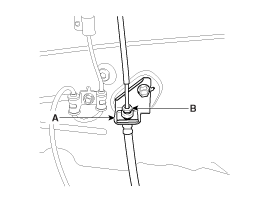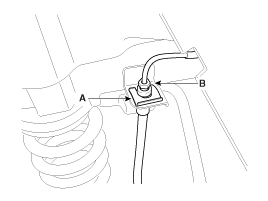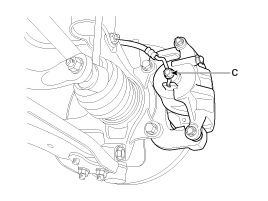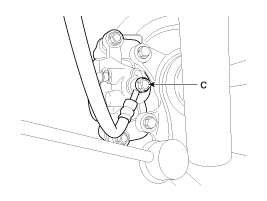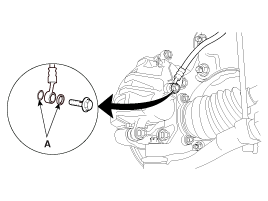 Kia Sportage: Brake Line: Repair procedures
Kia Sportage: Brake Line: Repair procedures
Third generation SL (2010–2016) / Kia Sportage SL Service & Repair Manual / Brake System / Brake System / Brake Line: Repair procedures
| Removal |
| 1. |
Disconnect the brake fiuid level switch connector, and remove the reservoir cap. |
| 2. |
Remove the brake fluid from the master cylinder reservoir with a syringe.
|
| 3. |
Remove the wheel & tire. |
| 4. |
Remove the brake hose clip (A).
Front
Rear
|
| 5. |
Disconnect the brake tube by loosening the tube flare nut (B).
|
| 6. |
Disconnect the brake hose from the brake caliper by loosening the bolt (C).
Front
Rear
|
| Inspection |
| 1. |
Check the brake tubes for cracks, crimps and corrosion. |
| 2. |
Check the brake hoses for cracks, damage and fluid leakage. |
| 3. |
Check the brake tube flare nuts for damage and fluid leakage. |
| 4. |
Check brake hose mounting bracket for crack or deformation. |
| Installation |
| 1. |
Installation is the reverse of removal.
|
| 2. |
After installation, bleed the brake system. (Refer to Brake system bleeding) |
| 3. |
Check the spilled brake oil. |
 Brake Line: Components and Components Location
Brake Line: Components and Components Location
Components
...
 Brake Pedal: Components and Components Location
Brake Pedal: Components and Components Location
Components
1. Cowl bracket2. Brake pedal member assembly3. Stop lamp switch4. Return spring5. Brake pedal stopper6. Clevis pin7. Snap pin8. Brake pedal
...
Other Information:
Components and Components Location
Component Location
1. Slide motor2. Rear height motor3. Reclining motor4. Power seat switch5. Reclining switch6. Lumbar support switch7. Lumbar support motor
...
Injector: Description and Operation
Description
Based on information from various sensors, the ECM can
calculate the fuel amount to be injected. The fuel injector is a
solenoid-operated valve and the fuel injection amount is cont ...
Categories
- Home
- Kia Sportage QL (2015-2019) Owners Manual
- Kia Sportage QL (2015-2019) Service Manual
- Kia Sportage SL 2010-2016 Owners Manual
- Kia Sportage SL 2010-2016 Service Manual
Copyright © www.kispmanual.com 2014-2025


